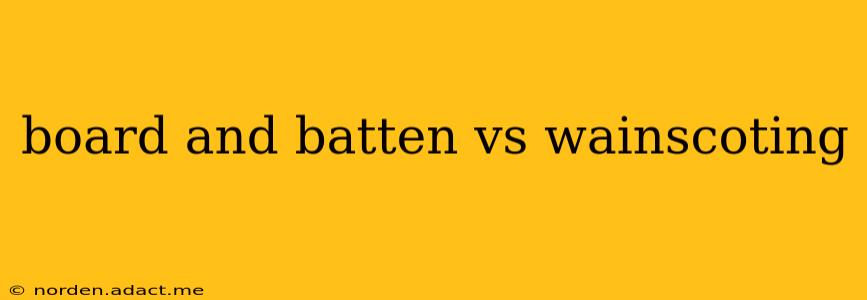Choosing between board and batten and wainscoting for your home's interior design can feel overwhelming. Both offer classic, timeless aesthetics, but understanding their differences is crucial for making the right decision. This comprehensive guide will delve into the nuances of each, highlighting their unique characteristics, applications, and overall impact on your space. We'll even answer some frequently asked questions to help you confidently select the perfect wall treatment.
What is Board and Batten?
Board and batten is a rustic and charming wall covering characterized by wide vertical boards (the "boards") separated by narrow strips of wood (the "battens"). The battens create a visually appealing, textured effect, adding depth and dimension to the walls. This style evokes a sense of warmth and traditional craftsmanship, often found in farmhouse or cottage-style interiors. The boards are typically spaced evenly, resulting in a clean, symmetrical look. However, variations in spacing and board width are possible for a more eclectic feel.
Advantages of Board and Batten:
- Rustic Charm: Its inherent simplicity and natural wood aesthetic create a warm and inviting atmosphere.
- Cost-Effective: Generally less expensive than wainscoting, making it a budget-friendly option.
- DIY Friendly: With the right tools and instructions, it's a manageable DIY project for many homeowners.
- Versatile: It adapts well to various interior design styles, from farmhouse and cottage to modern interpretations.
Disadvantages of Board and Batten:
- Maintenance: Requires periodic cleaning and potential refinishing or repainting to maintain its appearance.
- Limited Detailing: Compared to wainscoting, it offers less intricate detail or ornate molding.
- Not Ideal for All Styles: May not suit contemporary or minimalist interiors as effectively as wainscoting.
What is Wainscoting?
Wainscoting is a decorative wall treatment typically made of wood paneling, but can also incorporate other materials like MDF or plaster. It covers the lower portion of a wall, ranging in height from a few inches to several feet. Wainscoting can be incredibly versatile, offering various styles, including raised panel, flat panel, and beaded board. It provides a more formal and elegant look compared to the rustic charm of board and batten.
Advantages of Wainscoting:
- Elegant Appearance: Adds a touch of sophistication and refinement to a room.
- Durable: Provides protection for the lower portion of the walls, reducing wear and tear.
- Variety of Styles: Offers a wide range of designs to suit different interior aesthetics.
- Increased Home Value: Can add value to a property due to its perceived quality and craftsmanship.
Disadvantages of Wainscoting:
- Costly: Usually more expensive than board and batten, especially for intricate designs and professional installation.
- Installation Complexity: Can be more challenging to install, often requiring professional help.
- Less Versatile in Some Styles: Certain highly ornate wainscoting styles may not suit all decor themes.
Board and Batten vs. Wainscoting: Which is Right for You?
The best choice depends on your personal style, budget, and the overall aesthetic you aim to achieve. Consider these factors:
- Budget: Board and batten is generally more budget-friendly.
- Style: Board and batten offers a rustic charm, while wainscoting provides a more elegant and formal look.
- DIY Capabilities: Board and batten is easier to install yourself, while wainscoting often requires professional installation.
- Room Size: Wainscoting might make a smaller room feel smaller, while board and batten can make a large room feel more intimate.
How High Should Wainscoting Be?
The height of wainscoting is a matter of personal preference, but common heights include chair rail height (approximately 36 inches), halfway up the wall, or even extending to the ceiling for a dramatic look. The room's proportions and ceiling height should be considered when making this decision. Taller ceilings can accommodate higher wainscoting without making the room feel cramped.
Can I Use Board and Batten in a Modern Home?
Yes, absolutely! While board and batten is traditionally associated with rustic styles, its clean lines and simplicity can be adapted to fit modern interiors. Consider using a sleek, monochromatic color palette or incorporating unexpected materials like painted MDF for a contemporary twist.
Is Wainscoting Outdated?
Not at all! Wainscoting remains a timeless design element, and its versatility ensures it continues to find its place in modern homes. Its classic appeal transcends trends, and with various styles available, it can effortlessly blend with contemporary or traditional aesthetics.
By carefully considering the advantages and disadvantages of each and answering the key questions about your project, you can confidently choose between board and batten and wainscoting to create the perfect wall treatment for your home.
